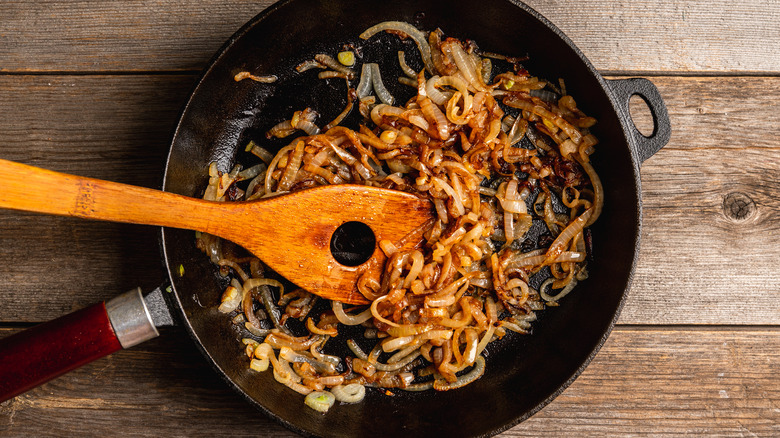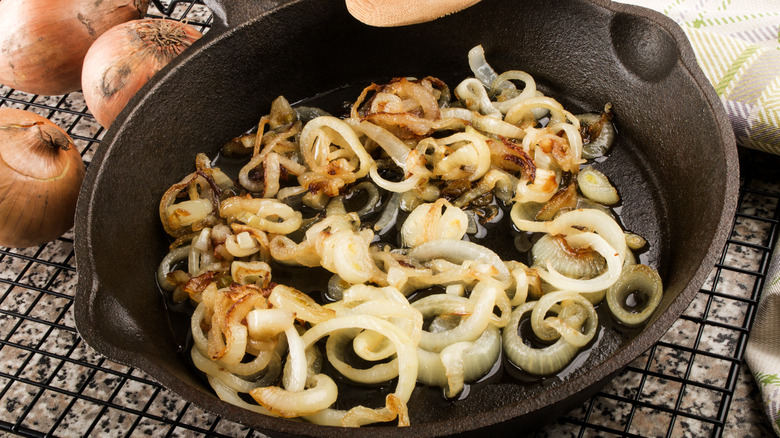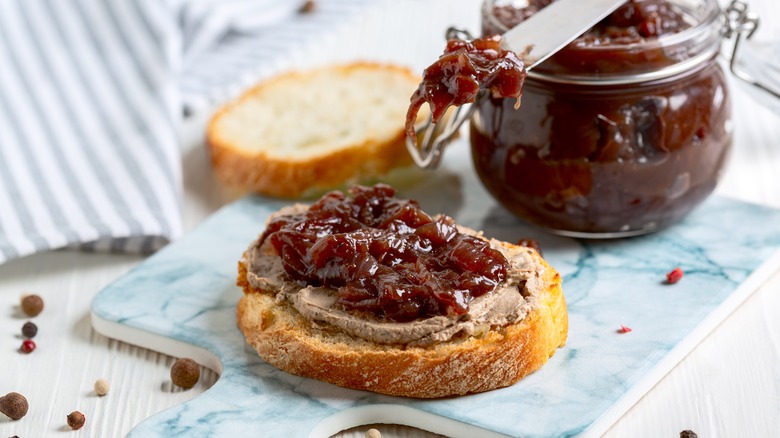The Skillet Mistake To Avoid For Perfectly Caramelized Onions
There are few things tastier than caramelized onions. Whether used as a pizza or sandwich topping or added to a soup, these slow-cooked alliums offer a delicious combination of sweet and savory flavors. However, caramelized onions have a reputation of taking forever to cook, and even after a long while, you might struggle to get them perfectly browned. If you've ever faced these woes, the problem might be with your cookware.
Using a pan that's too small or deep is one of the many common caramelized onion mistakes. You should use a wide pan, as more compact ones can end up steaming the onions instead of caramelizing them. Releasing steam is a key step in the caramelization process, but the onions have to get past that stage so they can brown. Much of their moisture must evaporate in order to concentrate their sugars, which leaves you with that gorgeous browned flavor and texture.
Wider pans have a greater surface area, and when sliced onions have more contact with a hot surface, their moisture evaporates better and they caramelize faster. A larger pan also helps you avoid overcrowding — when the onions overlap too much, they have a harder time releasing steam. Using a pan with sides that are too high may also prevent water from evaporating efficiently, and of course, adding too many onions to a pan also causes overcrowding. Generally speaking, a 12-inch skillet can accommodate 2 large onions.
Use this cookware material for the best caramelized onions
While the dimensions of your pan are a crucial component of the caramelization process, the material it's made of is another important factor. When caramelizing onions, a cast-iron pan is an excellent option. Despite the many myths surrounding cast iron cookware, these pans aren't fussy to use or maintain, and they have an impressive ability to retain heat and crisp up foods. Cast iron ensures that the onions brown evenly, and they're also optimal for deglazing the pan with liquid, a cooking technique you'll definitely want to use if you're making a soup, stew, or sauce.
As you cook the onions, you'll notice lots of tasty browned bits getting stuck to the surface of the cast iron. By pouring a liquid like stock, wine, or just water into the pan during or after the onion cooking step, you can lift these bits off the pan. Use the liquid in your recipe, and you'll be stunned at the extra savory flavor it adds. Deglazing only works at its best with certain types of pans, though, and that includes cast iron. Using a non-stick pan to cook the onions results in way less browned bits, which can rob you of precious flavor in the final dish.
Creative ways to use caramelized onions
Once you become a master of caramelized onions, and making them goes from a total chore to an easy task, you'll want to use them in all kinds of recipes. For a sophisticated spin on pizza, combine your caramelized onions with basil and goat cheese and spread over flatbread before baking in the oven. This preparation makes an excellent lunch or even a light dinner (especially when paired with a roasted tomato soup).
For something a bit more substantial, consider mixing caramelized onions with pulled pork for a hearty and flavorful sandwich. It may not be traditional, but no one will argue that the combo of sticky, sweet, and savory onions with juicy and tender pork makes for one of the best BBQ sandwiches ever.
Caramelized onions can also be combined with plums to make a complex, fruity, and utterly delicious chutney. Chutney is a type of preserve that can feature both sweet and savory flavors. The inherent sweetness of cooked onions melds wonderfully with tangy and juicy plums, and also meshes nicely any other ingredients you choose, like ginger, raisins, and apple cider vinegar. Spread the chutney on toast and crackers, or serve alongside roasted meat at a special occassion.


